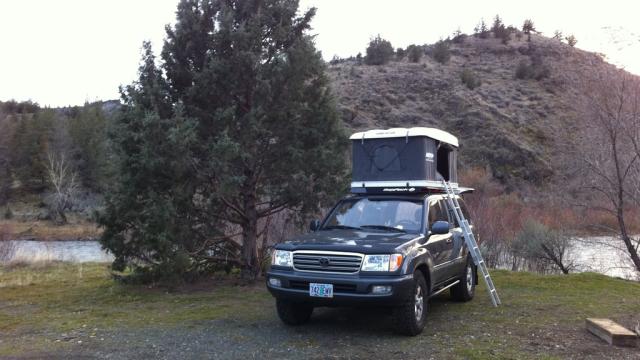If something is “popular in Europe”, would you take that as an indicator of refinement or of something overwrought? Because I’ve been sleeping like a hobo – a classy Italian hobo.
Rooftop tents are – according to stories I’ve been told by manufacturers of rooftop tents – a tradition that goes back decades in Europe, where families pop off to the Alps or cruise down to the Mediterranean in sporty diesel hatchbacks. When they’re not out camping, the tents can be stowed indoors. No need for a big camper van that you’ll only use a few times a year.
That’s the European angle: flexible, fuel-efficient (especially when not in use), and capable of being mounted to almost any vehicle. (There’s a corresponding South African mythos of rooftop tents, where sleeping on the tops of ancient Land Rovers is the best way to prevent a hippopotamus from mauling bwana’s genitals while he sleeps, but let’s pretend that I know nothing of this.)
I tested the Air Top, one of the fancier models of the Maggiolina line of hard-shell pop-up tents. While some Maggiolinas use a hand crank, the Air Top has four gas struts that are used to raise and support the fiberglass top. That makes set-up about as simple as can be: after unlatching two front clips and one rear clip, the top is open in about three seconds. It takes longer to reach up into the tent and pull down the included aluminium ladder than it does to open the tent.
Those same shocks can make putting the top back down a struggle, especially if your bedclothes take up too much space. I found myself more than once trying to clip the back just enough to keep it in place, then running up to the front of my truck to pull the front down, only to find I needed to undo the back to give myself some room to properly align both sides, which caused the back to spring open when I unclipped it, leaving the front to follow…
Two people is preferred. That said, after figuring out that I had overstuffed the interior or simply allowed the edges of my sleeping bag to get in the way of the corners of the floor, where the struts fold into themselves when the tent is closed, I was able to get the tent back down in something around a minute – pretty fantastic turnaround compared to flip-out rooftop tents or traditional stuff-in-bag units.
On road trips the Air Top was pretty incredible. Crashing in a rest stop or in a small town turnout is a lot more comfortable when you can stretch out on a mattress with a sleeping bag, blankets, and a proper, full-size pillow, all ready for you to go to sleep. (It took me a couple of nights to get used to the feeling of vulnerability that comes from sleeping in a tent in the parking lot of a remote desert rest stop, but I suppose it comes with the territory.)
I’ve spent something like 10 nights in the Air Top since installing it on my roof rack in late December, including one three-day trip through Death Valley (and subsequent drive back to Portland, Oregon). Temperatures varied considerably, but there has rarely been a night that it didn’t go below freezing. Even when the wind picked up – and trust me, you’ll know it’s windy in a roof-top tent since you’re sleeping in something not unlike a giant sail on top of your car – I stayed warm and comfortable. Or at least warm enough once I figured out my covering situation. The mattress that sits in the bottom of the Air Top is fairly firm and not terribly warm by itself, so putting down an afghan and then my sleeping bag on top of that worked best. And while the door flaps do a surprisingly good job of keeping the wind out despite a design which secures them at the bottom only by being tucked under the mattress, it pays to remember you’re still sleeping in a tent. A good sleeping bag or plenty of blankets are key. But it’s so nice to have the luxury of mixing and matching.
For the expedition-style adventurer, a flip-out tent might be a better solution. They’re often a bit roomier when opened up and can be found for half to a third of the price of a typical Maggiolina. (The Air Top starts at $US2800.) But you’d be hard pressed to find a rooftop tent with an easier setup than the Air Top. Even if you’re never going off tarmac, the Air Top would be a perfect solution for the perpetual road tripper or car camper.
That said, I spent three days on moderate trails through Death Valley with the Air Top mounted above and it never gave an issue. According to the American distributor, Autohome US, there’s a man in Bend, Oregon who has had an older model of Maggiolina for something like 12 years. Considering that the tents are essentially fiberglass shells, their durability is hardly surprising. (And could probably be easily patched up if it came to that, although fortunately I’ve kept this review unit in one piece.)
Gas mileage was affected – it got better. That’s because I had a new roof rack installed before adding the Air Top, which had greatly decreased my mileage with all the turbulence from the cross-members. (Or at least that’s my guess.) Adding the 60kg tent actually helped my gas milage by covering up the wind-eating bars.
There’s no doubt the Maggiolina line is expensive, thanks in part, I’m sure, to the fact that they must be imported by distributors here and are not sold direct by the Italian manufacturer. But there’s really very little else out there like them when you’ve decided to turn your little hatchback into an ersatz Vanagon for the weekend. [Autohome US]
